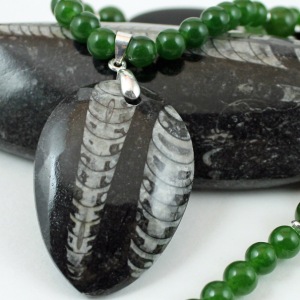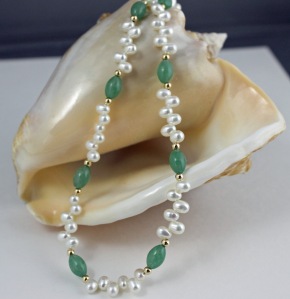I’m often asked if I make jade jewelry. The answer is yes… and no. That’s because there are two different gemstones that can correctly be called jade. They are similar in hardness and can sometimes be difficult to tell apart visually, but they are very different chemically. Both have been used for thousands of years for tools, decorative carvings and jewelry.
Things that ARE jade:
Nephrite Jade: chemical formula Ca2(Mg,Fe)5(OH)2. Nephrite is found in many countries including along the west coast of North America (sometimes called Canadian or B.C. jade) and also in Australia and New Zealand where it is often used for carved pendants. I’ve most commonly seen it in bright medium and dark greens to almost black but it can also be grayish or brown as well. Nephrite is generally more affordable than jadeite. Here’s an example of one of my recent pieces incorporating nephrite:
Jadeite Jade: chemical formula NaAlSi2O6. Jadeite is also found in the US and Canada, parts of Europe, and Myanmar. This is the jade that comes in colors including apple-green, white, and pale purple. It often has a mottled appearance. It is available as beads but tends to be very expensive.
Jadeite is commonly treated and has been categorized into 3 types based on this:
Type A – Natural, untreated, may have a surface coating of wax; “true” color.
Type B – Chemically bleached to remove impurities then impregnated with wax or polymers.
Type C – Dyed to enhance color; often chemically bleached and/or impregnated with wax or polymers.
Gems that can be confused with jade:
Aventurine: A quartz that gets its green color from inclusions of green chlorite mica. Aventurine is harder and significantly less expensive than either type of jade and has beautiful color. I often use it in my jewelry.
Unfortunately, some gemstones are given trade names that are descriptive rather than accurate. Some trade names are intended to make a stone sound more expensive or desirable. Here are a few examples with their actual identity:
African Jade: grossular garnet
Australian Jade: chrysoprase
Malaysia Jade: dyed translucent quartz
Mountain Jade: dyed high-grade dolomite marble
New Jade: serpentine
Olive Jade: serpentine
Buyer beware – don’t pay jadeite prices for nephrite, aventurine, or any of the other stones I’ve listed above. Proper gemological testing can easily identify these gemstones.
For more information:
http://www.gia.edu/jade
Nephrite:
http://www.mindat.org/min-2881.html
http://www.gemdat.org/gem-2881.html
Jadeite:
http://www.gemdat.org/gem-2062.html
http://www.mindat.org/min-2062.html


